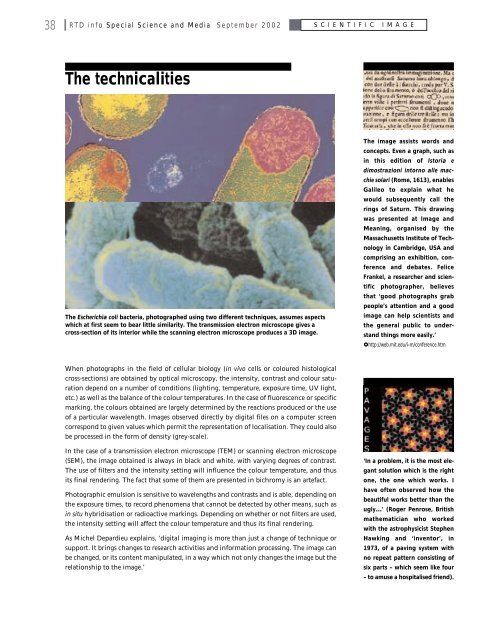RTD info - European Commission - Europa
RTD info - European Commission - Europa
RTD info - European Commission - Europa
Create successful ePaper yourself
Turn your PDF publications into a flip-book with our unique Google optimized e-Paper software.
38 <strong>RTD</strong> <strong>info</strong> Special Science and Media September 2002<br />
S C I E N T I F I C I M A G E<br />
The technicalities<br />
The Escherichia coli bacteria, photographed using two different techniques, assumes aspects<br />
which at first seem to bear little similarity. The transmission electron microscope gives a<br />
cross-section of its interior while the scanning electron microscope produces a 3D image.<br />
The image assists words and<br />
concepts. Even a graph, such as<br />
in this edition of Istoria e<br />
dimostrazioni intorno alle macchie<br />
solari (Rome, 1613), enables<br />
Galileo to explain what he<br />
would subsequently call the<br />
rings of Saturn. This drawing<br />
was presented at Image and<br />
Meaning, organised by the<br />
Massachusetts Institute of Technology<br />
in Cambridge, USA and<br />
comprising an exhibition, conference<br />
and debates. Felice<br />
Frankel, a researcher and scientific<br />
photographer, believes<br />
that ‘good photographs grab<br />
people’s attention and a good<br />
image can help scientists and<br />
the general public to understand<br />
things more easily.’<br />
#http://web.mit.edu/i-m/conference.htm<br />
When photographs in the field of cellular biology (in vivo cells or coloured histological<br />
cross-sections) are obtained by optical microscopy, the intensity, contrast and colour saturation<br />
depend on a number of conditions (lighting, temperature, exposure time, UV light,<br />
etc.) as well as the balance of the colour temperatures. In the case of fluorescence or specific<br />
marking, the colours obtained are largely determined by the reactions produced or the use<br />
of a particular wavelength. Images observed directly by digital files on a computer screen<br />
correspond to given values which permit the representation of localisation. They could also<br />
be processed in the form of density (grey-scale).<br />
In the case of a transmission electron microscope (TEM) or scanning electron microscope<br />
(SEM), the image obtained is always in black and white, with varying degrees of contrast.<br />
The use of filters and the intensity setting will influence the colour temperature, and thus<br />
its final rendering. The fact that some of them are presented in bichromy is an artefact.<br />
Photographic emulsion is sensitive to wavelengths and contrasts and is able, depending on<br />
the exposure times, to record phenomena that cannot be detected by other means, such as<br />
in situ hybridisation or radioactive markings. Depending on whether or not filters are used,<br />
the intensity setting will affect the colour temperature and thus its final rendering.<br />
As Michel Depardieu explains, ‘digital imaging is more than just a change of technique or<br />
support. It brings changes to research activities and <strong>info</strong>rmation processing. The image can<br />
be changed, or its content manipulated, in a way which not only changes the image but the<br />
relationship to the image.’<br />
‘In a problem, it is the most elegant<br />
solution which is the right<br />
one, the one which works. I<br />
have often observed how the<br />
beautiful works better than the<br />
ugly…’ (Roger Penrose, British<br />
mathematician who worked<br />
with the astrophysicist Stephen<br />
Hawking and ‘inventor’, in<br />
1973, of a paving system with<br />
no repeat pattern consisting of<br />
six parts – which seem like four<br />
– to amuse a hospitalised friend).

















